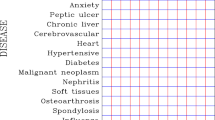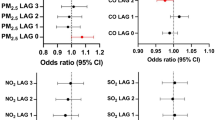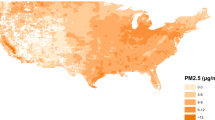Abstract
Substantial evidence supports an association of particulate matter (PM) with cardiorespiratory illnesses, but little is known regarding characteristics of PM that might contribute to this association and the mechanisms of action. The Atlanta superstation sponsored by the Electric Power Research Institute as part of the Aerosol Research and Inhalation Epidemiology Study (ARIES) study is monitoring chemical composition of ambient particles by size fraction, as well as a comprehensive suite of other pollutants, at a site in downtown Atlanta during the 25-month period, August 1, 1998–August 31, 2000. Our investigative team is making use of this unique resource in several morbidity studies, called the “Study of Particulates and Health in Atlanta (SOPHIA)”. The study includes the following components: (1) a time series investigation of emergency department (ED) visits for the period during which the superstation is operating; (2) a time series investigation of ED visits during the 5 years prior to implementation of the superstation; and (3) a study of arrhythmic events in patients equipped with automatic implantable cardioverter defibrillators (AICDs) for the period January 1, 1993–August 31, 2000. Thirty-three of 39 Atlanta area EDs are participating in the ED studies, comprising over a million annual ED visits. In this paper, we present initial analyses of data from 18 of the 33 participating EDs. The preliminary data set includes 1,662,713 ED visits during the pre-superstation time period and 559,480 visits during the superstation time period. Visits for four case groupings — asthma, chronic obstructive pulmonary disease (COPD), dysrhythmia, and all cardiovascular diseases (CVDs) combined — have been assessed relative to daily air quality indices, controlling for long-term temporal trends and meteorologic variables, using general linear models, generalized estimating equations and generalized additive models. Single-pollutant models predicting case visitation rates using moving averages of 0-, 1-, and 2-day lagged air quality variables were run. For the pre-superstation period, PM10 (24-h), ozone (8-h), SO2 (1-h), NO2 (1-h) and CO (1-h) were studied. For the first 12 months of superstation operation, the following air quality variables of a priori interest were available: ozone (8-h), NO2 (1-h), SO2 (1-h), CO (1-h), and 24-h measurements of PM10, coarse PM (PM 2.5–10 µm), PM2.5, polar VOCs, 10–100 nm particulate count and surface area, and in the PM2.5 fraction: sulfates, acidity, water-soluble metals, organic matter (OM), and elemental carbon (EC). During the pre-superstation time period, statistically significant, positive associations were observed for adult asthma with ozone, and for COPD with ozone, NO2 and PM10. During the superstation time period, the following statistically significant, positive associations were observed: dysrhythmia with CO, coarse PM, and PM2.5 EC; and all CVDs with CO, PM2.5 EC and PM2.5 OM. While covariation of many of the air quality indices limits the informativeness of this analysis, the study provides one of the first assessments of PM components in relation to ED visits.
This is a preview of subscription content, access via your institution
Access options
Subscribe to this journal
Receive 6 print issues and online access
$259.00 per year
only $43.17 per issue
Buy this article
- Purchase on Springer Link
- Instant access to full article PDF
Prices may be subject to local taxes which are calculated during checkout
Similar content being viewed by others
Author information
Authors and Affiliations
Corresponding author
Rights and permissions
About this article
Cite this article
TOLBERT, P., KLEIN, M., METZGER, K. et al. Interim results of the study of particulates and health in Atlanta (SOPHIA). J Expo Sci Environ Epidemiol 10, 446–460 (2000). https://doi.org/10.1038/sj.jea.7500106
Received:
Accepted:
Published:
Issue Date:
DOI: https://doi.org/10.1038/sj.jea.7500106
Keywords
This article is cited by
-
Impact of ambient fine particulate matter carbon measurement methods on observed associations with acute cardiorespiratory morbidity
Journal of Exposure Science & Environmental Epidemiology (2015)
-
Application of alternative spatiotemporal metrics of ambient air pollution exposure in a time-series epidemiological study in Atlanta
Journal of Exposure Science & Environmental Epidemiology (2013)
-
Associations between summertime ambient pollutants and respiratory morbidity in New York City: Comparison of results using ambient concentrations versus predicted exposures
Journal of Exposure Science & Environmental Epidemiology (2013)
-
Development and evaluation of alternative approaches for exposure assessment of multiple air pollutants in Atlanta, Georgia
Journal of Exposure Science & Environmental Epidemiology (2013)
-
Power estimation using simulations for air pollution time-series studies
Environmental Health (2012)



